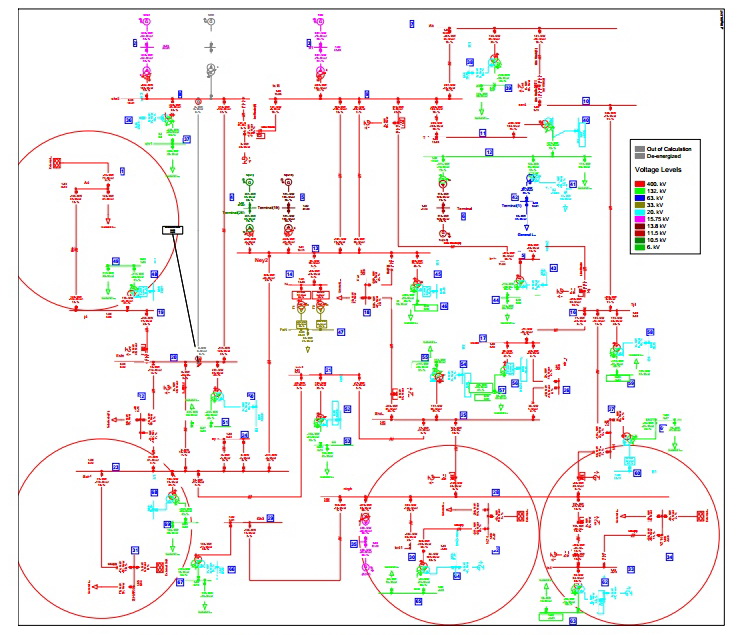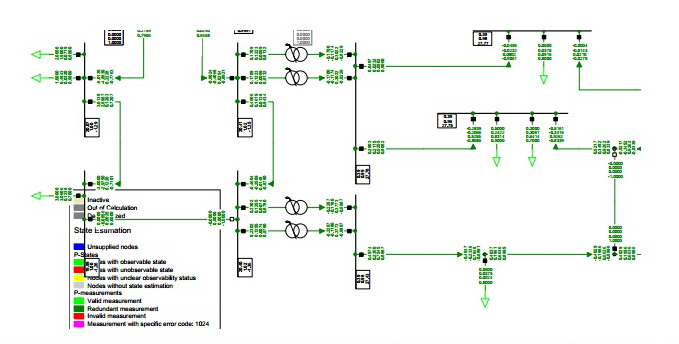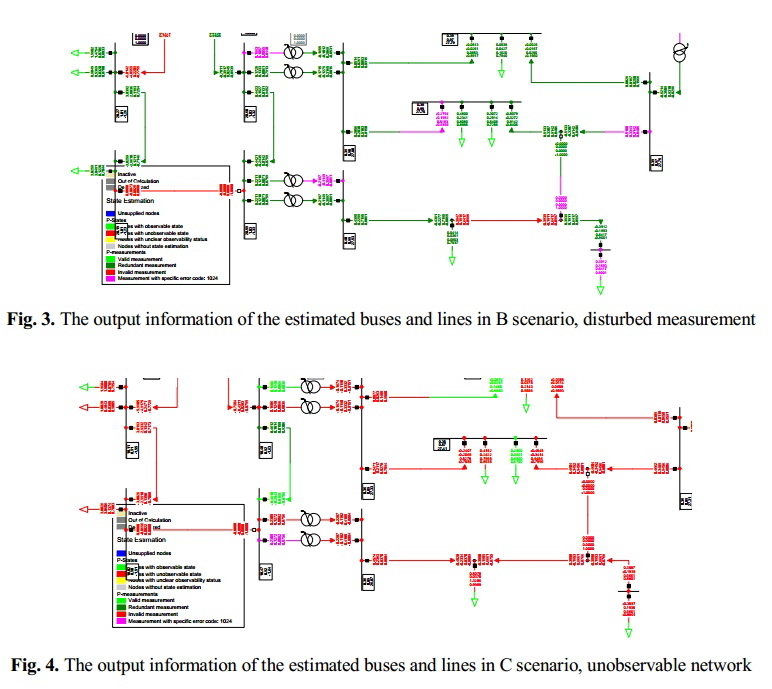OFFLINE AND ONLINE OF THE STATE ESTIMATION WITH DIGSILENT POWERFACTORY (PART 1)
Mustafa Eydyany0, Hojat Mehdipour1,
0Energy Security and Sustainable Energy Institute
1Energy Security and Sustainable Energy Institute
URL: https://ijesse.net/article/2
Abstract.
This paper is presented in two parts. The purpose of this paper is to present the state estimation and time domain simulation results generated by DIgSILENT PowerFactory software on a real network. The state estimation toolkit in DIgSILENT PowerFactory has been purchased by over 1000 regional power utilities and distribution companies worldwide. It is shown in this paper that you can use this software instead of Matlab and C++ software with DIgSILENT PowerFactory to estimate the state of a real network both offline and online. The program can estimate voltage, current, active and reactive power, as well as the state of transformer tap changers and network switches. A review of the relationship between cyber security and state estimation has also been conducted. As a final step, MatrikonOPC Simulation Server software and OPC (Object Linking and Embedding for process control) are used to demonstrate online network state estimation and online time domain simulation.
چکیده
چکیده: این مقاله در دو قسمت ارائه شده است. هدف این مقالهها ارائه تخمین حالت و بررسی نتایج شبیهسازی دامنه زمانی توسط نرمافزار دیجسایلنت پاورفکتوری در یک شبکه واقعی است. جعبه ابزار تخمین حالت در این نرمافزار، توسط بیش از هزار شرکت برق منطقهای و شرکت توزیع در سراسر جهان خریداری شده است. در این مقاله نشان داده شده است که میتوان از این نرم افزار به جای نرم افزارهای متلب و سی برای تخمین حالت یک شبکه واقعی هم به صورت آفلاین و هم آنلاین استفاده کرد. این برنامه میتواند ولتاژ، جریان، توان اکتیو و راکتیو و همچنین وضعیت تپ چنجرهای ترانسفورماتور و کلیدهای شبکه را تخمین بزند. در این مقاله رابطه بین امنیت سایبری و تخمین حالت نیز بررسی شده است. در آخرین مرحله، سرور شبیهساز ماتریکون و نرم افزار OPC برای کنترل فرآیند و نشان دادن تخمین حالت آنلاین شبکه و شبیهسازی دامنه زمان آنلاین استفاده شده است. کلمات کلیدی: نرم افزار دیجسایلنت، تخمین حالت، شبیهسازی زمانی، نرم افزار ماتریکون
1-Introduction
Everyone understands the benefits of state estimation (SE) in power systems, they include: * - Detecting incorrect measurements * - Estimation of quantities not measured * - Correction of measurement errors * - More accuracy in load flow. There are always problems that correct and complete information is not available because of equipment defects, measurement errors, disturbances, insufficient and inaccurate network topology information, the time difference between SCADA units, or information hacking. Therefore, it seems that to create a complete database, SE is required. Since there is not enough time to investigate and solve security issues by the system operator at any time, we can expect the system operator to perform more efficiently and properly if the information is transferred from the outputs of an automated system to simulation software like DIgSILENT PowerFactory (DIgSILENT) software. In an energy management system, the primary function is to support the control room's activities, such as analysis, planning, and correct and quick control of power system operation. By predicting the appropriate generation and transmission of energy, i.e. constant voltage and frequency, and stability of the network, we can provide sufficient energy when events occur. In this research, the online and offline SE program has been used in DIgSILENT software since hundreds of regional power companies and distribution companies and consultants use it in their simulations [1-4]. In order to compensate for incorrect or insufficient information, SE has been shown to be an effective alternative to normal load flow in DIgSILENT software [5-6]. The importance of the system operator in making decisions and making changes in the system illustrates the need for efficient software for analyzing network problems. As a result, the network information has been completed and optimized based on network automation outputs and methods for estimating state. Monitoring, controlling, and creating a perfect power system was made easier by sending network information and utilizing software capabilities to investigate various factors in a power system. SCADA systems send the information online in text files to the control centers, and DIgSILENT software can analyze the information and create commands to read and update them. DIgSILENT programming language (DPL) is used to transfer network information to software, and it requires the introduction of the required network information, as well as suitable programming to collect the data and execute the network check commands. This type of programming has many applications in network analysis, including determining voltage stability and available transfer capability (ATC) [7-8]. DPL is convenient for use in all DIgSILENT networks. In the previous section, we discussed the benefits and importance of using SE, and in this section, we will examine its problems, especially in the context of cyber security. Physical power systems and ICT infrastructure are interconnected through state estimation (SE) in modern energy management systems (EMS). As of today, SE is integral to EMS for security-constrained optimal power flow (SC-OPF), contingency analysis (CA), price computation, and ATC algorithms, and DIgSILENT is being used in most dynamic and static power system calculations for real networks [9-12]. SCADA measurements can be accurately injected with false data injections (FDI) using a typically integrated data attack. A multivariate attack bypasses SE's bad data detection (BDD) mechanism by changing a number of measurements together. Cyberattacks against SCADA networks in power systems are characterized by these capabilities. In EMS, failure estimates can influence more control measures because SE based on load flow models is input to many application-specific tools. Stealth attacks on power systems are typically measured by calculating the resources required to change certain measurements and remain undetected [13]. In addition, most of the reviewed literature still assumes adversaries have complete knowledge of the system, whereas in practice, an attacker may be able to construct a perturbed system model by decomposing and analyzing an old or estimated model [13]. The digitization and automation of the power system have increased control over the network and reduced costs [14], but the dangers of cyberattacks in the power system indicate that it has been misused. The unsafe use of state estimation programs will create new problems for the system since hackers can achieve their goals with complete or incomplete information. In order for the model-based methods to be effective, the dynamic model of the power system must be accurate, and the generated models of complex power systems are largely high-dimensional and non-linear. Since an accurate model of a real-time power system is not always available, high-fidelity simulators (e.g., DIgSILENT) are necessary to accurately describe the power system. Simulations in simulators can provide precise numerical models, while mathematical models containing dynamic systems or differential equations (such as Matlab) are simplified at the expense of software effectiveness. As a result, there is always a mismatch between the real power plant, the simulation model, and its mathematical model; therefore, implementing diagnostic tools based on the real system or the accurate simulated model is of little importance. For example, in the most recent references [13], the detection tools are implemented in a high-quality simulator (such as DIgSILENT) to improve the model-based detector. Further, more than a thousand regional power companies, distribution companies, and consultants use this software in their simulations and network state estimation programs. We will discuss state estimation methods in the second part of this paper, and we will present the network studied in the third part. The fourth section of this paper discusses how to model system parameters for state estimation. The conclusion and references are provided at the end [15-16]. In the second part of the paper, two more sections are presented. The fifth section shows the state estimation process. In the sixth section, we demonstrate a time-domain simulation using the OPC program (Object Linking and Embedding for Process Control).1- Introduction
1-1- OVERVIEW OF STATE ESTIMATION'S IMPORTANCE
1-2- STATE ESTIMATION (SE) AND CYBERSECURITY
1-3- WHY DIGSILENT?
1-4- PAPER TOPICS
2- State estimation methods
The accuracy of state estimation can be determined in a variety of ways. Statistical methods usually use data collected from meters to estimate the situation and estimate unknown values based on the data of these meters. Since measurements are usually inaccurate, estimated values will also be inaccurate. Therefore, to determine the accuracy of the estimated values, the following criteria are presented, which are based on some well-known criteria: * - The "Maximum Likelihood" criterion seeks to maximize the probability the estimate of the state variable is identical to its true value. * - Using the "Weighted Least Squares" criterion, the sum of the squares of the difference between the estimated and actual measurements should be minimized. * - Using the "Minimum Variance" criterion, we minimize the square of the difference between the estimated components of the vector of state variables and those that are similar to the real vector of state variables. The advantages of the state estimation algorithm in DIgSILENT Software include detecting the following: correct information from incorrect information, the direction measured power in transmission lines, very small or large amounts of information, correctly or incorrectly the sum of power or currents entered or output to a bus, the right number of measurements, and solving state estimation using nonlinear optimization programs. Since the early 19th century, state estimation based on least squares has been used for a wide range of purposes, but its application in aerospace has made significant progress. These applications aim to locate and estimate a space object's movement path using incomplete and additional measurements of its position and velocity vector. Over the past thirty years, state estimation techniques have been developed and used in the production sector and transmission line levels, which are usually based on the Weighted Least Squares (WLS) method [17]. The fast decoupled method with the same constraints for three-phase distribution systems is described in this section. A fixed and compressed gain matrix is transformed into two symmetric gain submatrices using this method. In this section, the WLS method is used to estimate state variables. A separate model of state estimation is investigated in order to separate active power-voltage angle from reactive power-voltage magnitude. The following relationship exists between measured and calculated values in state estimation: (1) In this case, Z is the measurement vector, h is the vector of nonlinear functions of the calculated values, x is the amplitude and angle state vector, W is the measurement error vector, m is the number of measurements, and n is the number of buses in the system. By minimizing the function, objective function can be obtained in state estimation using WLS. The diagonal elements of (R) are the measurement weight coefficients, which are equal to the inverse variance of the measurement. In order for the solution to be optimal, the gradient of the function J(x) must reach zero, that is: Where H is the Jacobian matrix and is as follows: It is acceptable to calculate the estimate using the repetition method, which can be obtained by solving the following equation in each iteration. G(xk) is defined as follows in the above relation. As a result of the discrete P-θ / Q-V principle of power systems, the following two equations can be written: The vectors Zq and Zq represent active and reactive measurements and the state vector (state variable) is defined by the following equation And H is the Jacobian matrix and is as follows: Ignoring the measurement error, we have: And: Where: If we ignore the sub-matrices, we can write the approximate Jacobian matrix and the gain matrix as follows: We can write the exact relationship of the gain matrix in the above equation if we consider the weight coefficients corresponding to the measurements. Now: The sub-matrices Hpθ and Hqv usually have the voltage magnitude of the whole bus equal to one per-unite, their voltage angle equal to zero, and ignore the branch series resistances in the formation of Hpθ. When using its equivalent bkm=-1/xkm, one can obtain (θ∆) and (∆V) successively by solving the normal equations. The difference between measured and calculated values can be written as (∆Zp) and (∆Zq). Next, we explain how to model system parameters for state estimation.2- State estimation methods




















3- Modeling system parameters for state estimation
The network studied in this paper is a summary of the power network in Iran with 84 buses, 7 power plants with 32 generators, 33 400 kV lines, 9 2-wire transformers, 17 3-wire transformers, 4 external network connections, 13 reactors, and 27 substations. Figure 1 shows its single-line diagram. Buses and generators have been given simplified names for simplicity. This section explains how to model the components of the power system for state estimation and symmetric load flow calculations. In load flow calculations, the active and reactive power of the loads are known and assumed to be voltage-independent. Depending on the type of study, the reactive and active power of the load is estimated as part of the state estimation program. The external networks connected to the network under study act as infinite buses in load flow, and their reactive and active power is determined by measurement in the state estimation program. As for generators in the load flow, the active power is specified, the generator buses are voltage controlled, and depending on the operating point, reactive power is generated. The active power and reactive power of the generators are estimated to state estimation mode, depending on the type of study. A transformer's tap can also be estimated in the state estimation program. Firstly, all network connections in this paper have measuring devices that are inaccurate in the real network. For an analysis of different scenarios, though, the meters had to be entered or exited at any time. The software can connect active and reactive power meters for each connection, as well as voltage and current meters. Voltage measurements are assumed to be unavailable in all studies. For this paper, three scenarios were used. A. Safe measurement: In this scenario, assume that all the meters are in the circuit and all of them show the same load flow value. The output information of the estimated buses and lines in Figure 2 is very close to the measured values, all buses are observable, and measurements are valid. B. Disturbed measurement: In this scenario, assume that all the meters are in the circuit, but some of them have noise. The output information of the estimated buses and lines in Figure 3 is very close to the measured values. However, the software has detected that some measurements are incorrect. C- Unobservable network. The problem in this scenario is not just that some meters are not functioning, but that some existing meters are sending incorrect values as well. The software detects all invalid measurements, as shown in Figure 4. In this case, load flow cannot be done due to a lack of information, but the state estimation program can, in addition to taking the load flow, distinguish the correct information from the incorrect. After each state estimation, the software colorizes the display information for each bus. At a glance, this gives a general overview of the network state. This information can be summarized as follows: *- Nodes with observable state *- Nodes with unobservable state *- Nodes with unclear observability status *- Nodes without state estimation *- Valid measurement *- Redundant measurement *- Invalid measurement *- Measurement with the specific error. 3- Modeling system parameters for state estimation

4- Network state estimation
Conclusion
DIgSILENT is a powerful software tool for solving the problem of state estimation in power systems, which is one of the most important practical challenges in power system operation. In this paper, it was shown that first of all, cyber security should be considered when using the state estimation program. The second benefit of using professional software is that you can estimate online and offline without having to use additional software or algorithms. Additionally, proper simulation allows operators to make more informed decisions based on network information.5- Conclusion
References
[1] State Estimation, DIgSILENT PowerFactory, 2017-2022. [2] V. Akhmatov, J. E. Nielsen, J. Østergaard, A. H. Nielsen, "State-Estimation of Wind Power System of the Danish Island of Bornholm", Nordic Wind Power Conference, NWPC, September 10-15, Bornholm, Denmark, 2009. [3] V. Akhmatov, "Bornholm Power System Model: Load-flow and State Estimation using DIgSILENT PowerFactory", Client User Manual, July 2009. [4] J. Alber , "State Estimation in PowerFactory: Algorithmic Aspects", RTE-VT workshop, Paris, May 29-30, 2006. [5] M. Eidiani and H. Zeynal, “Determination of online DATC with uncertainty and state estimation,” 2022 9th Iranian Conference on Renewable Energy & Distributed Generation (ICREDG), pp. 1-6, 2022. [6] M. Eidiani, H. Zeynal, Z. Zakaria, “Development of Online Dynamic ATC Calculation Integrating State Estimation”, The 2022 IEEE International Conference in Power Engineering Applications (ICPEA 2022), 7th to 8th March 2022. [7] M. Eidiani, S. M. Asadi, S. A. Faroji, M. H. Velayati, D. Yazdanpanah, “Minimum Distance, a Quick and Simple Method of Determining the Static ATC,” IEEE 2nd International Power and Energy Conference, pp. 490–493, 4762524, 2008. [8] M. Eidiani, D. Yazdanpanah, “Minimum Distance, a Quick and Simple Method of Determining the Static ATC,” Journal of Electrical Engineering: vol 11, Edition: 2, paper 16, pp. 95-101, 2011. [9] M. Eidiani, “A reliable and efficient holomorphic approach to evaluate dynamic available transfer capability,” International Transactions on Electrical Energy Systems, 2021, vol. 31, no.11, e13031, pp. 1-14, 2021. [10] M. Eidiani, “An efficient differential equation load flow method to assess dynamic available transfer capability with wind farms,” IET Renewable Power Generation, vol. 15, no.16, pp. 3843–3855, 2021. [11] M. Eidiani, “A New Load Flow Method to Assess the Static Available Transfer Capability,” Journal of Electrical Engineering and Technology, 19750102, 2022. [12] M. Eidiani, “A New Hybrid Method to Assess Available Transfer Capability in AC–DC Networks Using the Wind Power Plant Interconnection,” IEEE Systems Journal, article in press, 2022. [13] P. Kaikai, Pan, Towards Cyber-secure Intelligent Electrical Power Grids: Vulnerability Analysis and Attack Detection. https://doi.org/10.4233/uuid:4b4f9f96-237e-421b-82f4-97b1393ae507, 2020. [14] H. Zeynal, M. Eidiani and D. Yazdanpanah, "Intelligent Substation Automation Systems for robust operation of smart grids," 2014 IEEE Innovative Smart Grid Technologies - Asia (ISGT ASIA), 2014, pp. 786-790, doi: 10.1109/ISGT-Asia.2014.6873893. [15] PowerFactory OPC (Object Linking and Embedding (OLE) for process control) Guide, 2016-2022. [16] DIgSILENT PowerFactory, Advanced Tutorial, PowerFactory OPC Example, 2017-2022. [17] M. C. Pacis, A. M. I. Bernardo and S. A. D. G. Chu, "Phasor Measurement Unit (PMU) based Power System State Estimation with Distributed Generation (DG)," IEEE 13th International Conference on HNICEM, pp. 1-6, 2021. References
Download PDF Paper






 Copyright
©
Copyright
©